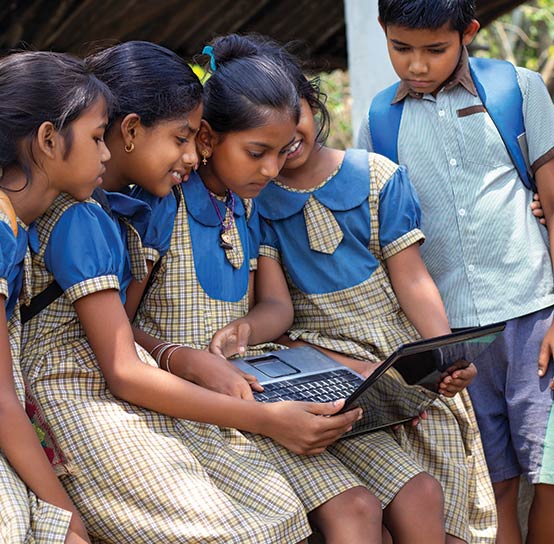-
Business Consulting
Our business consulting specialists offer a comprehensive blend of strategic advisory services. We assess the business, industry, operating model, synergy, skill sets and vision of the organisation and recommend the way forward
-
Digital Transformation Services
Grant Thornton’s digital transformation services help traditional businesses digitalise their business models with cloud technology, IoT consulting, app development and more DigiTech solutions.
-
Human Capital Consulting
Our Human Capital Consulting team harnesses technology and industry expertise to assist in constructing adaptable organisations with transparency, fostering productive and value-driven workforces, and inspiring employees to engage meaningfully in their tasks.
-
Production Linked Incentive Scheme
Production-linked Incentive Scheme by the Indian government is aimed at boosting manufacturing. Grant Thornton Bharat offers varied services across sectors to help businesses avail of this scheme.
-
Public Sector Advisory
Our Public Sector Advisory team has focused streams, aligned with the core priorities of the Government of India. We are responsible for providing innovative and customized technical and managerial solutions.
-
Tech Advisory
We have amalgamated Digital Transformation, IT Advisory & Information Management and Analytics into a new offering, DigiTech.
-
Direct Tax services
Our tax specialists offer a comprehensive blend of tax advisory, tax litigation, regulatory and compliance services, helping you navigate through complex business matters.
-
Indirect Tax Services
Get tax advisory service by leading tax firm Grant Thornton India. Our indirect tax services include advisory, compliance and litigation services for corporate, international and transaction tax
-
Transfer pricing services
Our transfer pricing services experts provide a range of services from provision of APA services to handling large global assignments including Country by Country reporting.
-
US Tax
At Grant Thornton, we help individuals and dynamic companies deal with US tax laws, which are one of the most complicated tax legislations across the world.
-
Financial Services - Tax
Best financial advisory services, tailored for small and large businesses by the experts having comprehensive knowledge of domestic laws and access to multifaceted tools to provide a valuable results.
-
Financial Reporting consulting services
Our experts have significant hands-on experience in providing IFRS/US GAAP services, end-to-end solutions and support services to fulfil financial reporting requirements.
-
Fund accounting and financial reporting
International operations often lack standardisation and have varied local reporting formats and requirements. Our experts can offer proactive insights, practical guidance, and positive progress and help meet regulatory timeframes.
-
Compliance and Secretarial Services
Our experts can assist in overhauling the entire compliance machinery of the organisation through evaluation of the applicable statutory obligations, monitoring of adequate governance controls, reporting and providing ongoing support.
-
Global People Solutions
As businesses transcend borders, both domestic and global considerations need equal attention. Our interim CFO and financial controller support services help organisations meet the business vision.
-
Finance and accounting outsourcing
Our accounting experts assist organisations in managing their accounting and reporting. Our dedicated Integrated Knowledge and Capability Centre (IKCC), allows us to service both the domestic and global markets efficiently and cost-effectively
-
Compliance Management System
We have automation solutions for you that will allow meeting government requirements and remain diligent, which when failed, can lead to penalties and loss in revenue.
-
IKCC: Grant Thornton's Shared Service Centre
The India Knowledge and Capability Centre (IKCC), aimed at delivering solutions by developing capabilities, has completed four years of its journey.
-
Global compliance and reporting solutions
At Grant Thornton Bharat, we meet the challenges of our clients and help them unlock their potential for growth. Our professionals offer solutions tailored to meet our clients’ global accounting and statutory reporting requirements. With first-hand experience of local reporting requirements in more than 145+ locations worldwide, we provide seamless and consistent international service delivery through a single point of contact.
-
Related Party Transactions Governance
Related Party Transactions Governance
-
Private Client Services
Private Client Services
-
Labour codes
Labour codes solutions help you transition through the new legislation. At Grant Thornton, we help businesses divide their approach to make sure a smooth transition.
-
Alerts
At Grant Thornton India, with the help of our tax alerts, we help to provide updates on how to minimise your tax exposure and risks.
-
Cyber
In today’s time, businesses have gone through large transformation initiatives such as adoption of digital technologies, transition to cloud, use of advanced technologies et al.
-
Governance, Risk & Operations
Our Governance, Risk and Operations (GRO) services encompass Internal Audit, Enterprise Risk Management, Internal Financial Controls, IT advisory, Standard Operating Procedures and other services.
-
Risk analytics
Grant Thornton Bharat’s CLEARR Insights is a state-of-the art data analytics platform that will help you in seamless data analysis and efficient decision-making.
-
Forensic & Investigation Services
The team of forensic advisory services experts consists of the best intelligence corporate experts, and fraud risk, computer forensic experts to deliver most effective solutions to dynamic Indian businesses.
-
ESG consulting
Grant Thornton Bharat offers holistic ESG consulting solutions for sustainable business outcomes. With industry expertise and AI technology, we drive long-term value.

-
Transaction Tax Services
Our transaction tax experts understand your business, anticipate your needs and come up with robust tax solutions that help you achieve business objectives ensuring compliance and efficiency
-
Deal Advisory
Unlike other M&A advisory firm in India, we offer deal advisory services and work exclusively with controlled and well-designed strategies to help businesses grow, expand and create value.
-
Due Diligence
Grant Thornton’s financial due diligence services are aimed at corporate looking for mergers and acquisitions, private equity firms evaluating investments and businesses/promoters considering sale/divestment.
-
Valuations
As one of the leading valuation consultants in India, Grant Thornton specializes in all the aspects of the process like business valuation services, financial reporting, tax issues, etc.
-
Overseas Listing
Overseas listing presents a perfect platform for mid-sized Indian companies with global ambitions. Grant Thornton’s team of experts in listings, work closely with clients during all stages.
-
Debt & Special Situations Solutions
Grant Thornton Bharat offers specialist debt and special situations consulting services, including restructuring, insolvency, and asset tracing solutions.
-
Financial Reporting Advisory Services
Financial Reporting Advisory Services
-
Financial Statement Audit and Attestation Services
Financial Statement Audit and Attestation Services

- Agriculture
- Asset management
- Automotive and EV
- Aviation
- Banking
- Education and ed-tech
- Energy & Renewables
- Engineering & industrial products
- FinTech
- FMCG & consumer goods
- Food processing
- Gaming
- Healthcare
- Urban infrastructure
- Insurance
- Media
- Medical devices
- Metals & Mining
- NBFC
- Pharma, bio tech & life sciences
- Real estate and REITs
- Retail & E-commerce
- Specialty chemicals
- Sports
- Technology
- Telecom
- Transportation & logistics
- Tourism & hospitality
-
India-UK
India-UK

While there are merits and demerits of both the old and new regimes, it becomes cumbersome for taxpayers to pick the best-suited tax regime. Here is a simplified assessment of both the regimes to answer a few pertinent questions
The Government of India introduced a new optional tax rate regime starting from April 1, 2020 (FY 2020-21), for the hindu undivided family (HUF). Consequently, Section 115BAC has been added to the Income Tax Act, 1961 (the Act) that prescribes reduced tax rates for individual taxpayers and HUFs on forgoing specified tax deductions or exemptions.
For an individual taxpayer, FY 2020-21 is the first instance where they get to choose between the old tax regime and the new tax regime while filing their income tax returns. In the wake of the Covid-19 outbreak, the due date to file the tax return which was on July 31, 2021 has been extended to December 31, 2021.
The extension is beneficial to those who are yet to file their returns as it also allows time to analyse both the regimes and opt for the most suited one. In case of those who have already filed their returns with this evaluation, a revised tax return can be filed till December 31, 2021.
Features of the New Tax Regime
Lower tax rates
The new tax regime has widened the scope of taxation with seven tax slab rates ranging from 0% to 30% with the highest tax rate applicable on income above INR 15 lakh. Contrary to the new regime, there were four tax slabs in the old regime from 0% to 30% with the maximum rate applicable on income above INR 10 lakh.
Here’s how applicable tax rates under both the regimes work:
| Income level (INR) | Old tax rate regime* | New tax rate regime |
|---|---|---|
| Up to 2,50,000 | 0% | 0% |
| 2,50,001 to 5,00,000 | 5% | 5% |
| 5,00,001 to 7,50,000 | 20% | 10% |
| 7,50,001 to 10,00,000 | 20% | 15% |
| 10,00,001 to 12,50,000 | 30% | 20% |
| 12,50,001 to 15,00,000 | 30% | 25% |
| Above 15,00,000 | 30% | 30% |
In the case of the old tax regime, tax rates are as applicable to individuals below the age of 60 years, including non-resident individuals.
Deductions/exemptions to be forgone while opting for new tax regime
The government has taken cognisance of the fact that the Act has various exemptions and deductions which make compliance by the taxpayer and administration of the tax laws by the tax authorities a burdensome process.
To give relief to taxpayers the simplified tax rate regime requires specified tax deductions and exemptions to be forgone. Therefore, it is important to evaluate the impact of deductions/exemptions being claimed vis-à-vis the benefit of lower tax rates. Some of the popular tax exemptions/deductions which are not allowed under new tax regime include:
- Leave travel allowance (LTA)
- House rent allowance (HRA)
- Children education allowance
- Standard deduction on salary
- Deduction for professional tax
- Interest on housing loan
- Deduction for specified investments or expenses under Chapter VI-A such as:
- deduction under Section 80C towards contribution to Public Provident Fund, repayment of principal on housing loan, children’s school fees, life insurance premium, etc.
- other deductions towards medical insurance premium, interest on education loan, etc.
Opting for the applicable tax regime
An individual or HUF taxpayer may opt for the new tax regime based on their specific situation and sources of income. Switching to the new tax regime can be done either on a year-on-year basis or only once. However, the frequency mostly depends on the source of income during the year.
Where income includes business or professional income:
In the case where an individual or HUF has income from a business or profession, once the option to avail new tax rates for a financial year has been exercised, the new rates shall apply for subsequent years. However, the law provides such taxpayers’ one single option of switching back to the old tax regime should their circumstances change. This switch-back option is available only once in a lifetime unless the taxpayer ceases to have any income from a business or profession.
Where income does not include business or professional income:
If an individual or HUF does not possess income from a business or profession, the selection can be made on a year-on-year basis. For individuals with salaries, the employer is required to withhold tax before the payment of the salaries. The employee is, however, required to inform the employer regarding their preferred tax rates.
An employee may choose between old and new tax regimes at the beginning of the year and intimate the employer, or at the time of joining new employment during the year. However, at the time of filling the personal tax return, the employee can change the tax regime.
For example, at the beginning of the year, an employee opts for the new tax regime and the employer deducts tax based on slab rates under the new tax regime. However, during the year they make certain tax-deductible investments like contribution to provident fund, payment of medical insurance premium, etc., and at the time of filing the income tax returns (ITR), they realise the old tax regime is more beneficial to them. In such a situation, they have the choice to opt for the old tax regime while filing the tax return though the employer had withheld taxes based on the new tax regime.
Which Tax Regime is Better?
Since the eligible deductions, sources and quantum of income differs for every individual, one rule cannot be applied to all. Taxpayers will need to evaluate and compare the tax liability under both regimes and then decide on which to opt for.
In case a taxpayer has investments in tax saving instruments, pays premiums on life or a medical insurance policy, children’s school fee, home loan principal repayment, etc., and avails the benefit of the deduction for HRA, LTA, etc. it may be more beneficial to opt for old tax regime since the benefit of deduction/exemption can be availed in the old tax regime.
Below is an illustration of how two taxpayers have the same gross income but are eligible for different tax deductions/exemptions.
Taxpayer 1 and Taxpayer 2 are salaried taxpayers with no other sources of income
| Details for FY 2021-22 | Taxpayer 1 (in INR) | Taxpayer 2 (in INR) |
|---|---|---|
| Income from Salary | 20,00,000 | 20,00,000 |
| Exemption for HRA | 1,20,000 | Nil |
| Exemption for LTA | 50,000 | Nil |
| Standard Deduction | 50,000 | Nil |
| Deduction u/s 80C for EPF, PPF | 150,000 | 150,000 |
Let us understand which tax regime is more beneficial for both the taxpayers
Taxpayer 1
| Old Tax Regime (in INR) | New Tax Regime (in INR) | |
|---|---|---|
| Income from Salary | 20,00,000 | 20,00,000 |
| Less: Exemption for HRA | 1,20,000 | Not applicable |
| Less: Exemption for LTA | 50,000 | Not applicable |
| Less: Standard Deduction | 50,000 | Not applicable |
| Less: Deduction under Section 80C for PF | 150,000 | Not applicable |
| Net taxable Income | 16,30,000 | 20,00,000 |
| Tax on the above | 3,13,560 | 3,51,000 |
We can see in the above example that the old tax regime is beneficialto Taxpayer 1 as taxes are less by INR 37,440.
Taxpayer 2: Does not have eligible exemptions for HRA, LTA
| Old Tax Regime (in INR) | New Tax Regime (in INR) | |
|---|---|---|
| Income from Salary | 20,00,000 | 20,00,000 |
| Less: Standard Deduction | 50,000 | NA |
| Less: Deduction under Section 80C for EPF | 150,000 | |
| Net Income chargeable under the head salary | 18,00,000 | 20,00,000 |
| Tax On the above | 366,600 | 351,000 |
In case of taxpayer 2, where deductions for HRA and LTA are not applicable, the new tax regime is more beneficial by INR 15,600.
How To Opt For New Tax Regime
Where income includes business or professional income
Taxpayers having income under head profit or gains from a business or profession and would like to opt for the new tax regime are mandatorily required to file the Form 10IE before filing the tax return. Similarly, Form 10IE is required to be filed by taxpayers who wish to switch back to the old tax regime
Form 10IE can be filed electronically, similar to efiling of the tax return by logging into the e-filing portal (https://www.incometax.gov.in/). Also, the form will be filed using either the digital signature or through an electronic verification code (i.e., EVC) as in the case of the tax returns.
The form requires the taxpayer to submit personal details such as name, PAN, address, date of birth, nature of business/profession, if applicable, and furnish details of any previous Form 10IE filed.
Where income does not include business or professional income
Taxpayers who do not have a business income are not required to file Form 10-IE and they can exercise the option under 115BAC while filing return of income in ITR 1 or ITR 2.
Bottom Line
Over the last few years, the government has taken various steps to move towards a simpler tax regime. Considering the peak rate of 30% and the peak surcharge on tax at 37% on income exceeding INR 5 crore, India still has one of the highest tax rates applicable to individual taxpayers. Therefore, there is room to make the new tax regime more attractive for a larger segment of individual taxpayers once the government considers further broadening the tax slabs aimed at balancing the impact of forgoing various deductions or exemptions.
To ensure you’re making the right decision, thorough learning about both the tax regimes is as paramount as staying updated about new amendments proposed by the government.
This article was originally published in Forbes.
